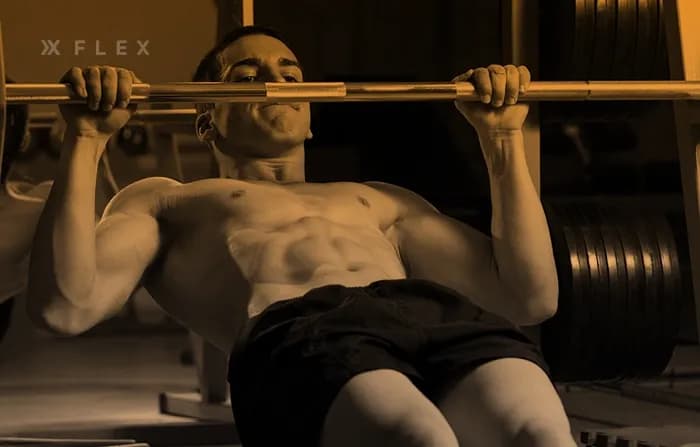4 Best Horizontal Pull Exercises for Your Back
This is a guide to horizontal pull exercises for your back. Learn how to ace your pull day with moves that work your back and shoulders.
Take your pull day from “just okay” to “yay!”
In this roundup, we’ll break down a few horizontal pull moves you should be incorporating into your pull-day routine in 2024.
What Are Horizontal Pull Exercises?
Horizontal pull moves consist of any exercise where you pull weight towards your body horizontally.
Think of things like cable pulls or rows.
Anything that uses a pulling motion to bring weight towards the body. These moves are known for building your back strength and helping to develop your shoulders.
Training horizontal pull movements can help you achieve more functional strength in your back to help with every day pulling activities outside the gym. They can also lead to muscular hypertrophy to give you a bigger back.
Guys especially tend to put a lot of emphasis on building the chest and abs. But getting a sexy back is just as important to create a balanced frame with a proportionate silhouette.
What Are the Benefits of Horizontal Pull Exercises?
Horizontal pull moves are also great for improving your shoulder health. Shoulder injuries are some of the most common ways you can get hurt during resistance training. Most of these, fortunately, are not severe. However, when you continue lifting heavy weights with improper technique, you risk causing mobility issues for your shoulder joints.
Horizontal pull exercises are also a great way to help alleviate back pain. Low back pain, especially, has become common in modern society. Around 60-80% of adults in Western countries experience lower back pain.
It can inhibit people’s ability to work and even participate in social activities.
Although it is correlated to age, obesity, and low-exercise lifestyles, anyone can experience low back pain.
Fortunately, this means anyone can take steps to optimize their workout routines to eliminate or reduce back pain.
Read on to find out more about horizontal pulling moves and what muscles in your back they will work. If you have pain concentrated in one area, try to pay extra attention to building muscle there.
And if you’re doing single-armed moves, make sure you train on both sides to prevent imbalances. Finally, after a back workout, a good stretch will always help sore muscles. Try foam rolling too, if you find you’re getting a lot of back muscle knots. Muscle scraping can be another recovery technique you may want to try to have your back feeling limber.
Horizontal vs. Vertical Pull Exercises
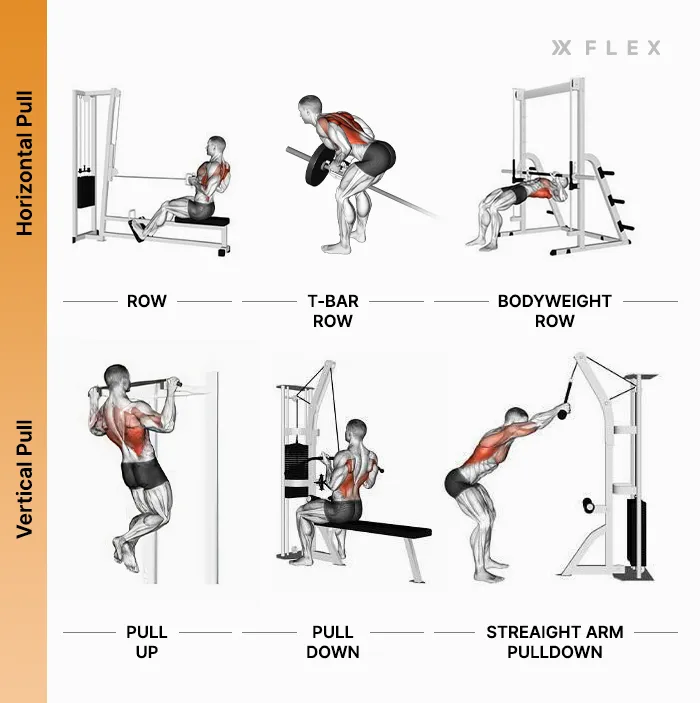
Are horizontal exercises better for you than vertical pulls?
Both can be good for you, however they do work your muscles in slightly different ways. Horizontal pulls are more concentrated on putting the work in your traps and rhomboids.
On the other hand, vertical pull moves like pull-ups concentrate a bit more work in your lats. Both types of pull work are great for building a big upper back.
That being said, only doing horizontal pulls or only vertical can create muscular imbalances. Try to focus on incorporating both types of work into your pull-day routine. You can even work diagonal pull moves that target vertical and horizontal pulling simultaneously. Exercises like the high row machine work a diagonal pull pattern if you want to double up.
What Muscles Do Horizontal Pull Exercises Work?
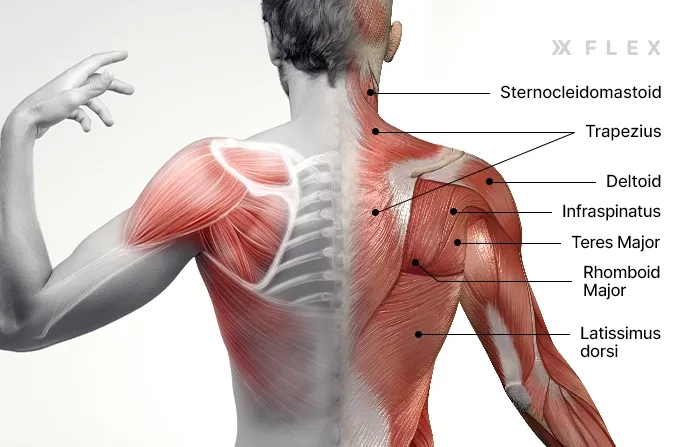
Horizontal pull moves are great back strengtheners and can also hit your arms and core.
Most horizontal pull moves focus on muscles like the:
Latissimus Dorsi
Your lats help you move your arms and shoulders. Connecting to the back, the latissimus dorsi are some of the biggest muscles in your body.
Rhomboids
The rhomboids retract, raise, and rotate your shoulder blades (scapulae).
Core
The abdominal muscles of your core are your primary stabilizers and help keep upper and lower body movement connected.
Forearms
The forearms help you move your wrists and hands.
Biceps
Your biceps help you flex your elbows. They also allow your arms to rotate.
Deltoids
Pull moves will hit your anterior deltoids. These muscles on the backs of your shoulders help you stabilize your shoulders and maintain your posture.
Pull exercises like machine or bent-over rows, for example, also incorporate some level of leg activation (either for stability or to drive the moves). That being said, you should be focused on contracting and engaging the back muscles if you want to feel the efforts of your pull day and use expert-level technique.
Upper Body Horizontal Pull Exercises
To get started on your pull day, here are a few of the best pull movements you can do to get a more defined upper body.
Let’s take a look at the best horizontal pull exercises you can try to get a sculpted back.
Cable Row
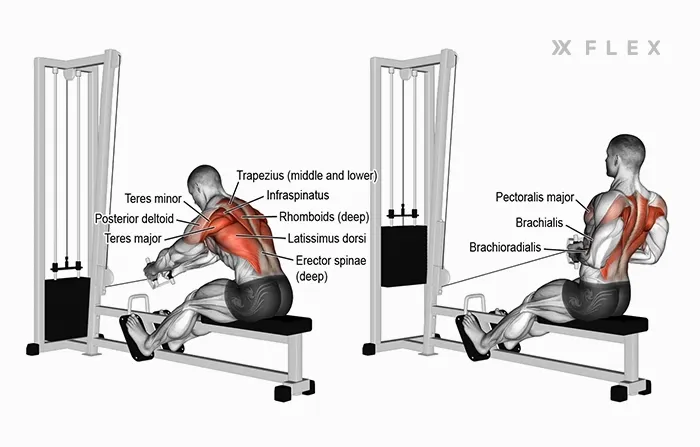
Cable rows work lats, trapezius muscles, rhomboids, and rear deltoids.
They also engage the arm muscles, including your biceps, triceps, and the brachialis and brachioradialis of the forearms. The core muscles engage to help you in this move, as well as the erector spinae along your mid-back. These muscles help keep your spine straight.
To perform a cable row:
- Sit at a cable stack on a weight bench. Load the weight to a medium-heavy load and plant your feet comfortably on the footpads.
- Grab the handles of your cable pulley attachment with your hands turned in to face each other.
- Engage your back and core muscles. Retract your shoulder blades in, pulling the weight towards you, keeping your chest proud.
- The cable handle should come up near your ribs at low chest height.
- Hold for a moment, keeping your back muscles engaged.
- Slowly extend your arms and bring the cable handle away from your body. Do not let the momentum yank or jerk your weight away.
- Repeat as needed.
Face Pulls
Face pulls work your upper back, traps, deltoids and the muscles of your rotator cuff. These are some of the best moves for shoulder health since the rotator cuff is known for being injury-prone.
To perform face pulls:
- Attach a rope handle to your cable pulley.
- Load a light to medium weight onto your stack.
- With one handle in each hand, grab your rope with a comfortable grip for you (this can take some trial and error).
- Step away from your pulley so there’s no slack in your cable. You can also do face pulls kneeling if you prefer.
- Pull your rope attachment toward your head, keeping one hand on each side of the face.
- Hold for a moment, then bring the rope back in front of you with control, maintaining the tension in your pulley.
- Aim for 3-4 sets of 10-12 reps.
@nicolekfit demonstrates how to perform face pulls to build your back.
TRX Row
Rows using TRX straps are a great alternative to any weighted horizontal pull moves if you prefer to use your bodyweight as resistance.
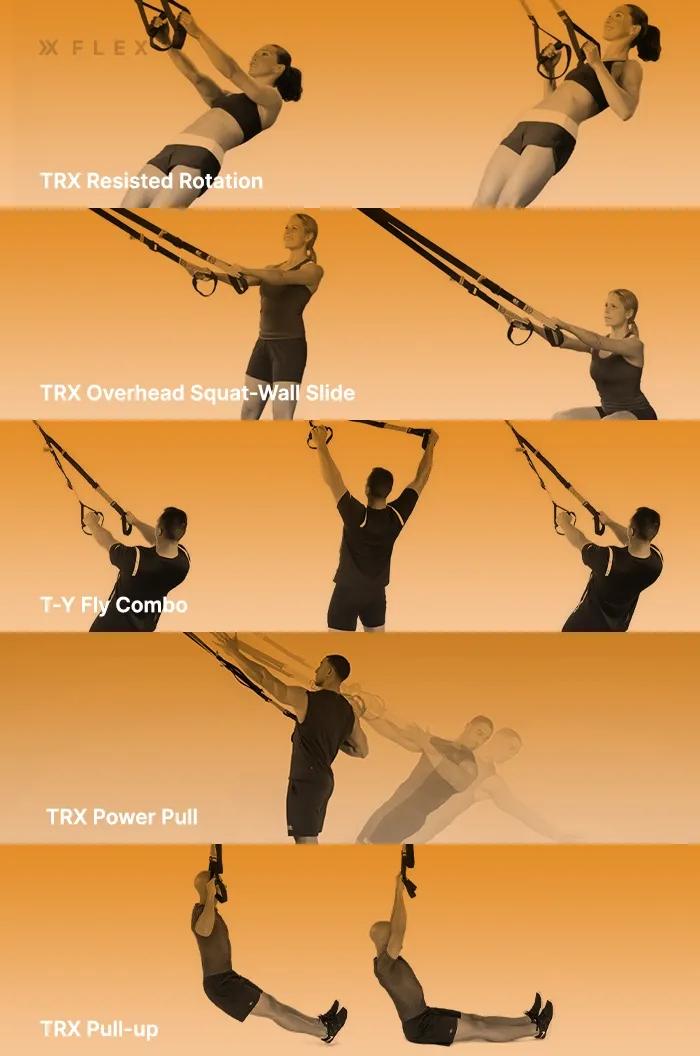
To perform TRX rows:
- Grab your TRX straps with your hands turned in to face each other.
- Step away from the anchor point to create tension in the straps and keep your arms extended out straight.
- Place your feet hip-width apart. Roll your shoulder blades back and start to lower your body down by leaning backward.
- Keep leaning until your body is in a diagonal line and your straight arms are keeping you suspended.
- Using your back, arms, and shoulders, pull your body upwards so your arms are bending and your strap handles come in near the sides of your torso. Aim for a 90-degree bend in your elbows.
- Hold for a moment, then gently and slowly lower your body back to the starting position keeping your core muscles braced.
- Repeat as needed.
Single-Arm Cable Row
- Sit at a cable stack on a weight bench. Load the weight to a light-medium load and plant your feet comfortably on the footpads.
- Grab one side of the cable pulley handle attachment. Keep the other hand at your waist or on your thigh for stability, so it doesn’t add torque to your movement.
- Engage your back and core muscles. Retract the shoulder blade of your working arm, pulling the weight towards you. Keep your chest proud.
- The cable handle should come up near your ribs at low chest height.
- Hold for a moment, keeping your back muscles engaged.
- Slowly extend your arm and bring the cable handle away from your body. Do not let the momentum yank or jerk your weight away.
- Repeat on the opposite side.
- Continue for as many repetitions as needed.
FAQ
Q: How many times a week should you do pull day?
A: If you’re working on a push-pull-legs split, aim to work out your pull muscles (mainly the back) twice per week. Do two push days and two leg days for an even split. This is assuming you work out 6 days a week with one day of rest.
Q: Is seated row a horizontal pull?
A: Yes. The seated row is one of the simplest horizontal pull moves you can do. Because you are sitting, this move is easy to try if you don’t have great stability. It can feel easier than a bend-over or standing cable row.
Seated rows are a great move for beginners to start making mind-muscle connections, focusing on activating the back muscles to create more targeted muscular work.
Q: Are bicep curls a horizontal pull exercise?
A: Bicep curls would technically be considered a vertical pull move, since the weight primarily moves up and down, not towards your body.
Since they only work one joint (the elbows), some people consider bicep curls to be an isolation exercise that doesn’t compare to compound vertical pulls like the pull-up or lat pulldown (which work multiple joints).
Big Picture
Horizontal pull moves activate the muscles in your back, arms, and the backs of your shoulders.
These target muscles like the latissimus dorsi, rhomboids, trapezius muscles, and anterior deltoids. If you want big shoulders and a crazy lat spread like a bodybuilder, working horizontal pulls should be considered essential work.
For stability, a lot of horizontal pull moves also require core strength, but these moves aim to build a big back.
Getting developed back muscles can be one of the most aesthetically pleasing ways to transform your body. Consider incorporating vertical pull moves too like neutral grip pull-ups or traditional pull-ups and you should begin to see your strength soar.
For men especially, a wider back and shoulders help give a defined physique, creating more width at the top of your body, tapering down towards some sexy V-lined abs will help you not only feel strong but look like a sex god.
Although women may not be as focused on back building, training pull moves can still help you balance out your top half, along with building a heart-shaped butt or transforming your square booty into a round one to get that coveted hourglass figure.
Work out like the best of the best. Flex AI offers an all-in-one workout platform to help you learn new exercises, visualize your fitness journey, and keep all your PRs in one place.
We’ve made it simple to work on customized fitness plans or to introduce a little friendly competition to your fitness community by sharing exercises with your friends. Try it for free through the Flex fitness app.
References
Durall CJ, Manske RCDavies GJ. Avoiding Shoulder Injury From Resistance Training. Strength Cond J. 2001;23(5): 10
Farrell C, Kiel J. Anatomy, Back, Rhomboid Muscles. [Updated 2023 May 16]. In: StatPearls [Internet]. Treasure Island (FL): StatPearls Publishing; 2023 Jan-. Available from: https://www.ncbi.nlm.nih.gov/books/NBK534856/
Gordon, R., & Bloxham, S. (2016). A Systematic Review of the Effects of Exercise and Physical Activity on Non-Specific Chronic Low Back Pain. Healthcare (Basel, Switzerland), 4(2), 22. https://doi.org/10.3390/healthcare4020022
Krzysztofik, M., Wilk, M., Wojdała, G., & Gołaś, A. (2019). Maximizing Muscle Hypertrophy: A Systematic Review of Advanced Resistance Training Techniques and Methods. International journal of environmental research and public health, 16(24), 4897. https://doi.org/10.3390/ijerph16244897
Lorenzetti S, Dayer R, Plüss M, List R. Pulling Exercises for Strength Training and Rehabilitation: Movements and Loading Conditions. Journal of Functional Morphology and Kinesiology. 2017; 2(3):33. https://doi.org/10.3390/jfmk2030033
Sanchez-Moreno, M., Pareja-Blanco, F., Diaz-Cueli, D., & González-Badillo, J. J. (2016). Determinant factors of pull-up performance in trained athletes. The Journal of sports medicine and physical fitness, 56(7-8), 825–833.
Related articles


Get fit with Flex
Build muscle & lose weight fast for free.
Available on iPhone + Apple Watch
